
Newton Highlands is one of the thirteen villages within the city of Newton in Middlesex County, Massachusetts, United States. The Newton Highlands Historic District includes residential and commercial businesses back to the late 19th century.

The following properties in Newton, Massachusetts are listed on the National Register of Historic Places. They are a subset of all properties in Middlesex County. There are over 180 places listed in Newton.
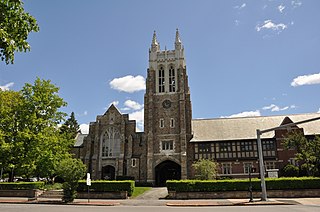
The First Unitarian Universalist Society in Newton occupies a prominent location at 1326 Washington Street in the heart of the village of West Newton in Newton, Massachusetts. Architect Ralph Adams Cram designed the church, Frederick Law Olmsted Jr. designed the grounds, the cornerstone was laid in 1905, and it was dedicated in 1906; it is one of the village's oldest buildings. The church is in Cram's signature Gothic Revival style, with buttressed walls and a blocky square tower with crenellations and spires. An enclosed courtyard is formed by an office wing, banquet hall, and parish house, which are built to resemble Elizabethan architecture with brick first floor and half-timbered upper level.

The Brackett House is an historic house located at 621 Centre Street in the Newton Centre village of Newton, Massachusetts. Built about 1844, it is a prominent local example of Greek Revival architecture, with a four-column temple front. Extensively damaged by fire in 2010, a careful restoration was completed in 2013. It was listed on the National Register of Historic Places on October 4, 1986.
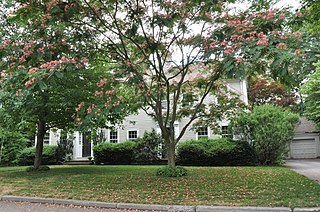
The Bartlett–Hawkes Farm is a historic house at 15 Winnetaska Road, in the Waban village of Newton, Massachusetts. With its oldest portion dating to about 1736, it is the oldest surviving building in Waban. Enlarged several times, it was moved to its present location from Beacon Street in 1915. It was listed in the National Register of Historic Places on September 4, 1986.
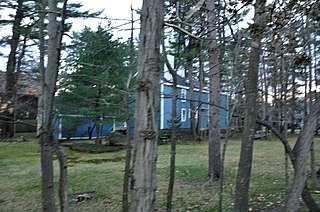
The Batchelder House is a historic house at 607 Pearl Street in Reading, Massachusetts. Built about 1783, it is a good local example of Federal period architecture. It is also significant for its association with the locally prominent Batchelder family, and as an early shoemaking site. The house was listed on the National Register of Historic Places in 1984.
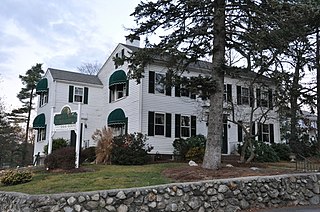
The George Batchelder House is a historic house in Reading, Massachusetts. Built in 1825, it is a prominent local example of Federal period architecture. It was listed on the National Register of Historic Places in 1984. It currently houses professional offices.

The Charles Newton House is a historic house at 24 Brattle Street in Worcester, Massachusetts.

The Brandeis University President's House, also known as the Leland Powers House, is an historic house on 66 Beaumont Avenue in Newton, Massachusetts. Built in 1913–14 for Leland Powers, it is a prominent large-scale example of American Craftsman architecture. It has served as the official residence of two presidents of Brandeis University as well as Roger Berkowitz, the CEO of Legal Sea Foods. The house was listed on the National Register of Historic Places in 1998.

The Pillar House is a house that was once located at 26 Quinobequin Road in Newton, Massachusetts, before being moved to its current location in Lincoln. It was built in 1845 and added to the National Register of Historic Places in 1986. It was removed from the National Register in 2024.

The Capt. Edward Fuller Farm is a historic farmstead at 59-71 North Street in Newton, Massachusetts. The original farmhouse is at #59, and the barn, now converted to a house, is at #71. The house is estimated to have been built c. 1775, possibly using materials from an even older structure; the barn is estimated to have been built in 1800. The house was original 1+1⁄2 stories, and was raised to its present 2+1⁄2 in the 1840s. The barn was converted to residential use c. 1950. The house was probably built by Edward Fuller, whose great-grandfather was one of the first settlers of the area.

The house at 173–175 Ward Street in Newton, Massachusetts is one of the city's few federal style houses. Built c. 1800, it is a 2+1⁄2-story wood-frame structure with clapboard siding and twin rear wall chimneys. The house has a five-bay facade with windows framed by narrow moulding. The main entrance is flanked by paired pilasters surrounding sidelight windows, topped by an entablature. The house was built by Charles Hyde and was involved in property disputes attending the construction of tunnels in the area in the mid-19th century.

The Hyde Avenue Historic District is a residential historic district encompassing the stylistic range of houses being built in the Newton Corner area of Newton, Massachusetts in the 1880s. It includes the five houses at 36, 42, 52, 59, and 62 Hyde Avenue, The district was added to the National Register of Historic Places in 1986.

The Eleazer Hyde House is a historic house located at 401 Woodward Street in Newton, Massachusetts.

The Gershom Hyde House was a historic house at 29 Greenwood Street in Newton, Massachusetts, US. One of the city's oldest houses, this Georgian-style farmhouse, c. 1744, was probably built by Gershom Hyde, one of Newton's early settlers. It was a 2+1⁄2-story wood-frame structure, five bays wide, with a side-gable roof, large central chimney, and clapboard siding. The rear ell and front porch were later additions. The house's location was along what was once a major road through the area.

Mount Pleasant is a historic two-story wood frame estate house in Newton Centre, Massachusetts, built circa 1856. It is a well-preserved example of the academic Italianate style of architecture, with a three-bay facade and hip roof with a small gable over the centered entry, and a three-story turret. The house was listed on the National Register of Historic Places in 1986.
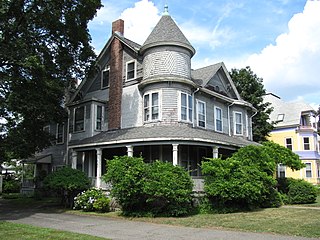
The Newton Highlands Historic District encompasses the historic heart of the village of Newton Highlands in Newton, Massachusetts. When it was added to the National Register of Historic Places in 1986, the district extended along Lincoln Street from Woodward to Hartford Streets, and included blocks of Bowdoin, Erie and Hartford Streets south of Lincoln Street. The district was enlarged in 1990 to include the cluster of commercial buildings on Lincoln Street between Hartford and Walnut Streets.

Chestnut Hill Reservation is a public recreation area and historic preserve surrounding the Chestnut Hill Reservoir in the Chestnut Hill and Brighton neighborhoods of Boston, Massachusetts, United States. The reserve is part of the Chestnut Hill Reservoir Historic District, is listed on the National Register of Historic Places, and is a City of Boston Landmark. It is managed by the Department of Conservation and Recreation.

Hartwell and Richardson was a Boston, Massachusetts architectural firm established in 1881, by Henry Walker Hartwell (1833–1919) and William Cummings Richardson (1854–1935). The firm contributed significantly to the current building stock and architecture of the greater Boston area. Many of its buildings are listed on the National Register of Historic Places.

The John Ward House at 184 Ward Street in Newton, Massachusetts is a Federal style house. It was deemed eligible for listing on the National Register of Historic Places in 1986, but its owner objected to the listing.























